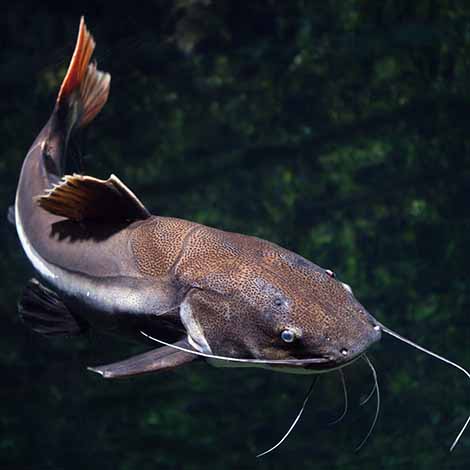Of all the fish species you could stock in your pond, catfish is an excellent choice. These bottom dwellers live in inland or coastal water on every continent, except Antarctica, and include some of the most varied fish on the planet. Channel catfish, the most common type stocked for sport fishing, thrives in shallow waters like your pond or lake.
Feeding Behavior
Catfish are well known for being scavengers. They'll eat just about anything they can find on the bottom of a pond. Their anatomy makes this task easy - they are negatively buoyant, which means that they generally sink rather than float thanks to a small gas bladder. Catfish also sport a flattened head that allows for easy digging through debris, a mouth that acts as a substrate suction and a body covered in taste buds.
Catfish have little effect on the predator-prey relationship in freshwater environments comparative to predators like bass or prey like bluegills. To supplement the natural diet of the catfish in your pond, we recommend adding Airmax EcoBoost PRx. It adds more than 80 trace minerals to the water, promoting fish growth. We also suggest feeding Game Fish Grower Fish Food to ensure your catfish have enough food and to increase their overall size.
Ideal Environment
Channel catfish prefer warmer water (about 60° to 70°F) in areas with little or no currents. They thrive in small and large rivers, reservoirs, natural lakes and ponds. Channel cats are cavity nesters, meaning they lay their eggs in crevices, hollows or debris, to protect them from swift currents.
In your pond or lake, catfish won't reproduce if they lack an adequate spawning structure. We suggest adding Porcupine Fish Attractors to help improve fishing conditions and provide an attractive habitat for catfish to spawn and grow.
During seasonal change, you may notice color changes in your catfish. Sometimes, the changes are caused by natural reasons like age, spawning and temperature fluctuations. Other times, their coloring lightens from environmental causes like stress and disease.
Your pond fish likely looked darker in the spring or fall - for good reason! The cooler water holds more oxygen, which your fish need to thrive and look their best. In warmer water, oxygen levels tend to drop off. The lack of sufficient oxygen, coupled with poor water quality, can cause your pond fish to stress. When stressed, they're more prone to disease and other issues, which can cause their color to lighten.
Troubled Waters
Because these guys are bottom dwellers, they can stir up a lot of debris or clay. That will contribute to cloudy, murky water. Aeration can help. Airmax Aeration Systems increase the oxygen in your pond, circulate the water, promote the colonization of beneficial aerobic bacteria and help maintain clear water.
Ultimately, your decision comes down to personal preference. Catfish are well suited for pond life. They have little effect on the predator-prey relationship in freshwater environments compared to predators like bass or prey like bluegills. Plus, they make for good fishing. What's not to love about catfish!
Last Updated: February 2, 2023
